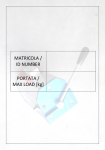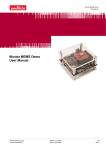Download Paper - Asee peer logo
Transcript
AC 2010-1383: AN INDUSTRY-SPONSORED CAPSTONE PROJECT: A STORY OF SUCCESS Khalid Al-Olimat, Ohio Northern University Page 15.155.1 © American Society for Engineering Education, 2010 An Industry—Sponsored Capstone Project: A Story of Success Abstract This paper presents a capstone project that has been sponsored by American Electric Power (AEP). AEP, like other companies, relies on shippers to move equipment long distances. Sometimes during these trips, the shipped object is damaged, causing financial losses. AEP requested a device which monitors when and where damages occur. A device was designed which gives AEP this capability. Since the duration of a shipment may be up to two months, the device must contain an adequate power supply. The device records multiple impacts as well the location, date, and time of each impact. It contains a timer which can be used to record each impact in the event that Global Positioning System (GPS) satellites are not available. Collected data is written to a memory card so it can be retrieved using a PDA or laptop. The monitoring device consists of a Programmable Interface Controller (PIC), an accelerometer, a GPS receiver, a memory card slot, and other electrical components. When an impact occurs, the PIC logs the value of the acceleration and activates the GPS device to determine the time and the device’s present location. If the GPS device is unable to receive a signal, the PIC will record the time of the impact. The PIC sends this information to the memory card. A software package developed to work with this device enables the end user to view a map indicating where each impact occurred. The impact data is retrieved by inserting the memory card into a PC or PDA. Information about the strength and time of each impact is displayed on a map. The design project has won first place as the best design project at Ohio Northern University (ONU) and second place in the IEEE-Student Activities Conference 2009. The paper presents the technical content of the design, the assessment of the design with respect to ABET criterion a-k, and the advantages of and recommendations for industry-sponsored projects. Introduction The senior design course -also called senior capstone design project - is an important component of engineering curriculum worldwide. The course is a senior level course with a common objective which is to mainly allow students to reinforce their technical skills and to integrate and apply them to solve engineering problems. ABET1 states the definition of engineering design as “Engineering design is the process of devising a system, component, or process to meet desired needs. It is a decision-making process (often iterative), in which the basic sciences, mathematics, and engineering sciences are applied to convert resources optimally to meet a stated objective. Among the fundamental elements of the design process are the establishment of objectives and criteria, synthesis, analysis, construction, testing, and evaluation.” Simply, engineering design is the use of theoretical knowledge to bring useful systems to reality. Page 15.155.2 The structure of senior design experience varies from one university to another. Some universities offer this course as a one semester course and others offer it as a year-long course. ONU requires students to take a year-long (three quarters) senior design sequence. The sequence consists of three courses; senior design seminar (2-credit hours), senior design (3-credit hours), and engineering technical communication (1-credit hour). The list of senior design projects is given to students in the last week of spring quarter of their junior year. Students are asked to list their top three choices from the given list. The faculty members of the department meet and distribute the projects to students taking into consideration the factors of students’ choices and their technical abilities to form the senior design teams. This ensures that each team has a fair chance of success. The team size depends on the project’s needs. Typically, each team consists of 3-4 students. One faculty member in the department assumes the responsibility of the senior design coordination. The other faculty members serve as team advisors. The list of projects consists of both faculty-sponsored projects and industry-sponsored projects. The focus of this paper is on the industry-sponsored projects. Typically, the industry-sponsored projects are more challenging because the problems offered by the industry are real-world and practical problems. In addition, since the partnering industry provides financial support, they are interested in the project outcome. ONU became a member in the American Electric Power (AEP) University-Alliance Program in 2007. AEP has sponsored seven excellent projects in the past 08/09 academic year at ONU. The author advised the project presented in this paper. The project, entitled "Design of Equipment Impact Monitor" was a complete success by all measures. It won first place among all senior design projects in the ECCS department at ONU, and second place in the 2009 IEEE Student Activities Conference. In addition to the project technical design, a discussion of the design process, the assessment of the design based on ABET criteria, advantages and some recommendations are presented. Design of Equipment Impact Monitor2 Page 15.155.3 Overview American Electric Power (AEP) is a power utility company based in Columbus, Ohio. AEP, like other companies, relies on shippers to move equipment long distances. Sometimes during these trips, the shipped object is damaged, causing financial losses. AEP requested a device which monitors when and where damages occur. A device was designed which gives AEP this capability. Since the duration of a shipment may be up to two months, the device must contain an adequate power supply. The device records multiple impacts as well as the location, date, and time of each impact. It contains a timer which can be used to record each impact in the event that Global Positioning System (GPS) satellites are not available. Collected data is written to a memory card so it can be retrieved using a PDA or laptop. The monitoring device consists of a Programmable Interface Controller (PIC), an accelerometer, a GPS receiver, a memory card slot, and other electrical components. When an impact occurs, the PIC logs the value of the acceleration and activates the GPS device to determine the time and the device’s present location. If the GPS device is unable to receive a signal, the PIC will record the time of the impact. The PIC sends this information to the memory card. A software package developed to work with this device enables the end user to view a map indicating where each impact occurred. The impact data is retrieved by inserting the memory card into a PC or PDA. Information about the strength and time of each impact is displayed on a map. Problem Statement The economy of the world is currently in a state of change. Demands are rapidly increasing as previously third-world countries develop into sizeable economies. To take advantage of new markets, manufacturers must learn to cheaply manufacture a product at point A and ship it to point B. Companies must explore alternative methods of improving efficiency to remain competitive in the world market. Although people have transported goods for thousands of years, there are still areas of transportation that can be improved. In an effort to attract a larger share of the transportation market, shippers sometimes decrease quality to increase efficiency and cause damage to shipped goods. Presently, shippers and their clients must come to an agreement before the product is shipped. An insurance policy is negotiated beforehand based on whether or not the cargo arrives damaged or not damaged. There is currently no way to prove that the damage occurred when the shipper had possession of the cargo. System Specifications Specifications given by AEP were used to measure the success of the system at the completion of the project. The following specifications outline the operation and capabilities of the designed system: • • • • The device must record up to 1000 impacts as well as the location, date, and time of each impact. The device must contain a real time clock, which can be used to record each impact in the event that GPS satellites are not available. Once satellites are available, the device must synchronize the real time clock and previous readings with the current satellite time. The device must be able to store information by writing it to a memory card that can be read using a PC or PDA. The device must be able to operate on a single power supply for at least two months. Design Deliverables AEP requested a list of specific items to be delivered upon successful completion of the project. The following list outlines the items that must be given to AEP: • • Page 15.155.4 • • • • Project box containing all components for the impact monitoring device Packaged software to be installed on a personal design assistant (PDA) or laptop with a Windows or Linux operating system Short manual detailing the successful use and assembly of the product All relevant source codes with instructions for compiling Circuit schematics Logic block diagrams • • Complete schematics for finished device including dimensions and electrical specifications Inventory list with associated prices for all materials and parts used in the project Implementation Considerations There are several implementation considerations for this project. Although these considerations are similar to constraints, they provide more specific goals for the design. These considerations are: power consumption, cost, reliability, and size. Power consumption was the most important consideration in the working device. The device must consume a minimal amount of power, while still allowing it to function properly. If the device were to lose power during operation, valuable data would be lost. Power consumption must also be minimized because the size of the device is limited. Specifically, the device should draw an average current of less than 15 mA at 3.3 V. High power consumption requires large batteries, which in turn would create a bulkier device. The cost of the device must be low. Other devices that record impacts cost in the range of a few hundred dollars. To remain competitive, the final cost of the device must be less than $200. If the device proves to be useful, AEP may seek to mass produce it. A strategy to reduce the price of the device includes choosing components with multiple purposes. The device must be reliable in normal shipping conditions. It must be able to survive multiple impacts and still function properly. Considerations must be made in choosing the proper container and components to ensure that the device is durable. Environmental factors such as temperature and humidity must also be considered in choosing the case and electronic components. If the device fails because it is unable to tolerate the normal wear and tear of shipping, it will be rendered useless. The size of the device must be kept to a minimum for several reasons. It will be mounted in shipping containers. A large project case could create problems in finding a good place to mount the device. If the device is bulky, this may create difficulties in maneuvering the goods to be transported into the shipping container. To allow for easy transport of the device, it must be easy to handle. A smaller device would allow a shipment manager to carry several monitoring devices at once. Hardware Description The tracking device is made up of a Programmable Interface Controller (PIC), an accelerometer, a serial GPS receiver, a memory card slot, and various analog components. The device will continuously monitor for impacts. If an impact occurs, the accelerometer registers the acceleration of the impact and sends it to the PIC. The PIC then logs the value of the acceleration and activates the GPS device to receive information about the time and location of the impact. If the GPS device is unable to receive a signal, the PIC logs the time of the impact from an on-chip real time clock (RTC). The PIC sends this information to the memory card. Appendix A shows a flow chart of the operation of the device. Page 15.155.5 The software package for the device can be loaded onto a PDA or personal computer. It will enable the end user to view a map indicating where each impact occurred. The software will also display information about the strength and time of each impact. Programmable Interface Controller: The Programmable Interface Controller (PIC) is an integral part of the device. It is responsible for communicating with peripheral devices that monitor impacts, obtaining location and time information, and storing information to a memory card. Based on these communication needs, the PIC needs to be capable of interfacing with two different protocols: universal asynchronous receiver transmitter (UART) and serial peripheral interface bus (SPI). The PIC must also consume a minimal amount of power. To ease development, the microcontroller should support a higher level programming language. Communication capabilities are of utmost importance in this project. If the PIC is not able to interface with each peripheral device successfully, one or more goals of the project will not be completed. At the same time, the PIC must be as efficient as possible. A PIC with sufficient communication capabilities normally has a larger pin count and consumes more power since it has extra features that are not needed. On most PICs the function of each pin is predetermined, with different functions sometimes requiring the same pins. There are two ways to meet the communication needs for this project: choose a PIC with many input/output pins, or choose a PIC with the capability of switching the communication protocol used by each input/output pin. The second method was chosen because it allows the device to consume less power and be contained within a smaller package. Microchip Inc. makes a wide variety of microcontrollers and was chosen to supply the PIC for this project because of its range of development tools. There are multiple devices that may be able to accomplish the goals of this project, but the chosen PIC is from the PIC24F family. Table 1 shows the PIC families that were considered for this project. Table 1: PIC Families Family PIC24F dsPIC30 PIC18F Primary Purpose Sensor Motor Control Multi-Purpose Architecture 16-bit 16-bit 8-bit Sensor Flexibility High Medium Low Memory Capacity High Medium Low The PIC24FJGA002 is a 28 pin microcontroller. It consumes less than 1 mA when running from a low power RC oscillator (LPRCO) and is also capable of running at speeds up to 32 MHz. For the purposes of this project, the PIC is driven by the LPRCO when monitoring the accelerometer. When an impact occurs, the clock speed increases from 31 kHz to 8 MHz to allow communication with peripheral devices. The microcontroller has two SPI modules, two UART modules, a 10 channel 10-bit analog-to-digital converter, and 16 reprogrammable pins. It contains 22 KB of program memory. At $1.92 per chip, it provided the best value. Page 15.155.6 Accelerometer: One of the most crucial components in the impact monitor device is the accelerometer. An accelerometer is a device that can be used to numerically measure the accelerations acting on an object. The accelerometers considered for this project output an analog signal with a voltage proportional to the acceleration experienced. In the impact monitor, these analog signals are sent to the analog-to-digital converter (ADC) on the microcontroller, where they are converted to numerical values and stored on the memory card. It is essential that the impact monitor make use of an accelerometer that measures acceleration on three axes since impacts may occur in any direction. In addition to having the ability to measure acceleration on multiple axes, other requirements need to be met. The accelerometer must have low power requirements, be reasonably priced, and withstand the forces of a journey. The ADXL family was recommended by AEP. Two other accelerometers were considered, the SCA3000-DO1 and the MMA7260Q. All measure acceleration in three dimensions, but the ADXL330 outperformed the other accelerometers in terms of sensitivity and power consumption. It draws only 0.35 mA and measures accelerations in the range of ± 3 g. Table 2 shows the decision matrix which summarizes why the ADXL330 was chosen. Table 2: Accelerometer Decision Matrix Weight SCA3000-DO1 MMA7260Q ADXL330 Cost 0.3 1 3 2 Power 0.4 1 2 3 Reliability 0.3 3 1 3 1.6 2 2.7 Total GPS Device: A GPS device is necessary to record the location of each impact. It is also responsible for setting the real time clock of the device. The best GPS device for this project is one which has low power consumption, low cost, small size, sufficient gain to obtain satellite fixes through walls, and is simple to interface with a microcontroller. The stand-alone GPS device contains all necessary hardware to receive and process satellite signals to GPS coordinates. This information is outputted through a UART interface. The advantage of this setup is that there is no extra programming needed to calculate GPS coordinates. The disadvantages of this setup are its cost and power consumption. Most standalone GPS devices cost greater than 50 dollars. The power consumption is also relatively high since it includes its own processor to determine coordinates from the satellite signals. Few stand-alone GPS devices were found that could be used in this project. Nearly all other choices required the purchase of a separate smaller antenna. The EM-408 GPS receiver was chosen because it had a relatively small size and an internal antenna. Memory Card: The memory card for the device is used as a storage device for impact information obtained from the accelerometer and the GPS device. AEP personnel will be able to retrieve the data from the memory card by inserting it into a PC or PDA. A developed software package is able to retrieve and display the required data. Page 15.155.7 MultiMedia (MMC) and Secure Digital (SD) cards are the two popular devices used for flash memory storage. Both are capable of using the SPI protocol to communicate with a microcontroller. Although both formats are usable, MMC was chosen over SD because it was less expensive. Power Supply: Since the device will be mobile, it will require a battery to provide power for as long as two months. The power supply provides a voltage source for each component. All components use 3.3 V input voltage. Based on current measurements which will be described later, it was concluded that four D cell batteries connected in series would provide an adequate power supply. To stabilize and step down the voltage from the batteries, two voltage regulators were used. One was used to power the PIC and GPS device, and the other was used to power the memory card. LM882 voltage regulators were chosen because of their low idle current and large input voltage range. Development Process and Issues After the decisions were made about which components would be used in the project, different parts were interfaced to the PIC. The clock speed and power consumption of the PIC was reduced by turning on the low power RC oscillator. The accelerometer was interfaced to the PIC by changing the appropriate register values and writing a procedure which could measure the output values. Communication between the PIC and the GPS device was established by changing appropriate registers and writing a procedure which would store the received values. In other words, the microcontroller’s A/D registers were set to measure output values from the accelerometer. To do this the registers were set to identify: the pins being used on the PIC, the voltage reference for the internal A/D, the analog conversion clock, and that the output would be represented as an integer. The UART Registers of the microcontroller were set so that the microcontroller would receive and transmit data through a UART interface. The registers were also manipulated to set the baud rate of the transmitting and receiving lines, along with the stop and parity bits, and interrupts. The impact monitor and software were developed in parallel. The software converts the information into a .kml file which can be read by Google Earth. Impact information is parsed and shown graphically at the site of each impact. Programmable Interface Controller: One of the main requirements of this project was to have the monitor device consume a minimal amount of power. The electrical specifications found in the data sheet for the microcontroller indicated that the PIC would draw less power when operated at a slower clock speed. There were two options for changing the internal clock speed of the PIC. The first is to prescale the fast internal RC oscillator. The second option is to use the internal low power RC oscillator (LPRCO). Programming the PIC to use the LPRCO presented a challenge since it was the first task with an unfamiliar microcontroller to the team. The PIC manual described a process to switch oscillators, but all attempts failed when using this method. The solution was found by examining an example program. The program included a built-in command which switched to the desired oscillator. To test that the PIC was truly operating at a slower speed, a program was executed which pulsed the LED outputs before and after the oscillator change. Page 15.155.8 A watch dog timer (WDT) and real time clock (RTC) were developed for the device. The WDT is used as a fail-safe. If something were to cause the PIC to freeze, the WDT resets the PIC. The RTC is used in case valid GPS information cannot be obtained. A clock within the PIC synchronizes with satellite time at the first valid GPS fix. If an impact occurs when GPS signals are not available, the timer information will be stored on the memory card in place of the GPS information. Since it will be unknown where this impact occurred, the software estimates the location based on stored clock information. Accelerometer: The PIC contains several peripheral options, one of which is a built-in ADC. Analog signals from the accelerometer vary based on acceleration. The ADC of the PIC was used to measure the outputted information. The operating manual of the PIC was the only resource needed to interface the accelerometer with the microcontroller. Registers were set to enable analog-todigital conversion for the pins attached to the accelerometer. The only issue encountered in interfacing the accelerometer was a mistake made in deciding which pins to use. Some of the originally selected pins were used by the debugger, which caused the implementation to fail. This was remedied by using different pins. Once the ADC was working properly, a procedure was written to determine if an impact was beyond a threshold value. A running average of the previous twenty values was used to determine the standard force. This allows subtle movements over a long period of time to not be recorded as impacts. When a movement causes a change of 20% or more above the threshold, an impact is recorded. GPS Device: Another peripheral option present on the PIC is the ability to communicate using the UART protocol. To allow communication between the GPS and the PIC, the UART module was initialized. The main reference was the PIC’s data sheet, which showed the appropriate registers to change to enable UART communication. In UART communication, it is necessary to specify the bit rate, parity bits, and stop bits. This information was found in the GPS module’s data sheet and was set in the PIC’s registers. The GPS module’s data sheet indicated that the device transmitted with no stop bits and no parity. This configuration is not possible and that proves the documentation was incorrect and corrupted. The correct configuration was found by assuming the most common configuration of one stop bit and no parity. The data rate was found to be 9600 bps by trial and error. A procedure was written to capture and process the received GPS data into a string which showed present position, time, and date. The setup was tested and successfully captured the correct data. Memory Card: Data storage is an integral part of this project; a relatively small amount of impact information must be stored on a non-volatile memory device until it is retrieved. So far, this has been the most challenging part of the project. Several example projects were considered to interface the PIC with an MMC card. Most of these example projects modify the FAT file system present on MMCs. None of the examples worked with the device’s setup. The other option was to store data in a raw format on the card. Writing data in the raw format is less desirable because the card must be formatted before it can be used again. Page 15.155.9 The only option was to write a unique MMC driver. The driver created is very simple; it is capable of reading and writing a single 512 byte data block. It was found that a text file created on a formatted card is always stored at the same memory address. By writing to the address of the text file, it was possible to use the simple MMC driver to write information to a formatted card without manipulating the file system. Writing to the memory card without manipulating the file system was desirable because it simplified the driver. Overwriting the text file data allowed the computer data retrieval program to be simpler because it did not have to find data on a memory card with no file system. Power Supply: It was possible to make rough power estimations for the end device based on individual data sheets, but a better estimation of power consumption was made after the device was built. A debugger and development board were used to interface the microcontroller with other peripheral devices. Since the device was powered from the computer, it was not practical to make power measurements using this setup. The move from a debug environment to a standalone battery powered device was not difficult. The compiler was changed from debug mode to release mode. The microcontroller was programmed and all peripherals were circuited using a bread board. The primary means of reducing power consumption was to turn off or disable power hungry peripheral devices when they were not in use. Together, the GPS unit and memory card draw 80 to 100 mA. The microcontroller and accelerometer draw a combined 1.45 mA when using the LPRCO. To create the 3.3 V source needed to supply all components, two LM882 voltage regulators were used. A single voltage regulator and a transistor switching scheme was used to turn on and off the GPS and memory card. This combination led to write errors in the memory card. Using a separate voltage regulator for the memory card reduced the number of write errors, most likely because it isolated the transmit and receive signals from the noisy GPS unit. This setup also reduced the idle current from 2.6 mA to 1.45 mA. Power measurements were made using a voltmeter and an ammeter. Both were attached to the input voltage rail of the device. At full power, all components are operating and the device draws an average of 100 mA. When the device is listening for impacts, it draws 1.45 mA. In a worst case scenario, the device operates at full power 10% of the time. If the device operated 10 % of two months, it would run for 144 hours. Assuming each impact takes 2 minutes of operating time, the device could measure 43,200 impacts. Table 1: Battery Life at 90% Idle Capacity (mAH) Life, T, Hours Life, T, Days AA 2,890 255.6 10.7 C 8,350 738.6 30.8 D 20,500 1,813.4 75.6 Table 1 shows the projected maximum operating time for three types of batteries. The D cell batteries provide more than two months of operating time. Page 15.155.10 Software Package: A software package which displays the impact data graphically was created in parallel with the impact monitor. The software is able to read the information stored on the memory card and pin point each impact location using Google Earth. Each pin point shows the time, date, and acceleration value of an impact. Appendix C shows an example image produced using the software package and Google Earth. The program operates by reading information from the memory card and storing it onto a .kml file which can be read by Google Earth. In the event that GPS information was not available when an impact occurred, the location is estimated based on the previous locations and the impact time. Budget Expenses have been divided into development costs and the cost of a single impact tracking monitor. Table 2 summarizes the hardware and costs needed to complete the project. Table 3 shows the cost estimation for a single impact monitor. The total cost of the project is $1063 and the cost to build a single tracking unit is $143. Analog components are listed in both cases; these components include: resistors, capacitors, voltage regulators, antennae, and connectors. The prototype boards were made and provided by the department’s technician. The cost of labor was estimated based on the pay rate of $35 per hour. The hours worked per quarter were based on the tasks that were scheduled in the Gantt chart. The breakdown of the labor budget is shown in Table 4. The labor cost for this project is $28,875. Table 2: Development Budget Product PDA GPS Accelerometer Battery Case PIC Development Kit PIC24FJ64GA002 Memory Card Memory Card Socket Analog Components Quantity 1 3 3 2 1 1 10 3 2 - Price Per Unit $400 $65 $35 $10 $5 $230 $2 $10 $4 Total Total Price $400 $195 $105 $20 $5 $230 $20 $30 $8 50 $1063 Table 3: Device Budget Product GPS Accelerometer Battery Memory Card Misc. and Analog Components Case PIC Memory Card Socket Total Price $65 $35 $10 $10 $12 $5 $2 $4 $143 Table 4: Labor Costs Hours 25 150 350 300 595 Cost $875 $5,250 $12,250 $10,500 $28,875 Page 15.155.11 Quarter Summer Fall Winter Spring Total Constraints In preparation for the design of the device, certain real world constraints needed to be acknowledged. These constraints guided the design process by providing a general basis on which to make specific design decisions. Economic: Economic considerations include the cost of staffing hours, the cost of devices, and the cost of miscellaneous development equipment. In order to minimize the cost of labor, the design of the device was made as simple as possible. The number of components was kept low to reduce the cost of the finished device. The amount of parts was minimized using components that serve multiple purposes. In order to facilitate easy manufacturing and lower design cost, the device contains as few components as possible. Integrated circuit (IC) components were chosen such that a single IC provided several needed features. Although similar devices are already available on the market, no single device provides the same set of features as the proposed device. The designed device competes with these similar devices by having lower final price per unit. Sustainability: The device is producible with available and easy to obtain resources. In the event of a failure, the problem is resolvable by replacing only the faulty component. Each component is replaceable with standalone and easy-to-find parts. Health & Safety: The device must be restricted to a container such that there are no exposed wires or components. A specification plate will be attached to the device with all necessary information, such as voltage, current, and power ratings. Additionally, warnings will advise the user of possible hazards and inform the user that the device’s parts comply with the Restriction of Hazardous Substances (RoHS) Directive. The RoHS directive was originally a law adopted by member states of the European Union. It limited the amount of dangerous substances present in electrical equipment. The directive is becoming an international standard for production of new electronic devices. Manufacturability: In order to facilitate easy manufacturing and lower design cost, the device contains as few components as possible. Integrated circuit components were chosen such that a single IC can provide multiple needed features. By placing all components on a single printed circuit board, it is durable enough to survive likely impacts which will be experienced by the device. Ethical: Page 15.155.12 The purpose of the device is to hold a shipper responsible for damage incurred during shipment. The device should be tamper proof so that the data log cannot be manipulated. The device has the potential to infringe upon personal privacy by tracking an object without its owner’s knowledge. Considerations were made to prevent this possibility. Environmental: To minimize the environmental impact of the device, it must consume a small amount of power, contain a minimal amount of hazardous chemicals (lead, arsenic, etc.), and withstand corrosion at high humidity. It must also not secrete dangerous chemicals in harsh environments (melting plastic in high temperatures). Steps should be taken at the design stage to accomplish these goals. Social: The purpose of the device is to hold shippers accountable for mistakes during shipment. This could change the relationship between shippers and their clients. Shippers are likely to be more careful and cautious with shipments. Their clients may reconsider placing blame on a shipping company if the device showed no damaging impacts occurred. Political: The device must not output electromagnetic noise that violates FCC regulations. Individual peripheral devices meet FCC regulations, so it follows that the combination of these devices are compliant as well. The device follows local and international laws regarding RoHS compliancy since all components are RoHS compliant. Concluding Remarks The purpose of this project was to develop an impact monitoring device capable of recording the acceleration, location, and time of several impacts. This was accomplished by using the given system specifications and required design deliverables to create potential designs. Potential components were researched to determine which ones were ideal based on the requirements of the project. Once specific components were chosen, development began and proceeded until the goals of the project were met. A device was built which meets the initial design specifications given by AEP. The device was to record at least 1000 impacts. It has been tested to record at least 2500 impacts and can potentially record more than 43,000 impacts. The device was to contain a real time clock which can keep time in the event that a GPS signal cannot be acquired. A crystal oscillator was chosen that is accurate to within ±1 minute per year. It has been successfully integrated into the circuit design and the microcontroller keeps time as expected. The device was to store the impact information to a memory card for later retrieval by a PDA or computer. The device is capable of writing to a memory card which is readable by a developed software package. The device was to have a battery life of at least two months. Under worst case conditions, the device can sustain itself for 75.6 days. Although the major specifications of the project have been met, a suitable container must be chosen for the device. The best off-the-shelf potential containers for the device are outside junction boxes. These boxes are designed to shelter electrical components and provide an environment free of humidity. So the container is selected and the device is housed. The designed device is delivered to AEP. Page 15.155.13 Discussion of the Design Process Per ABET1 definition, “Engineering design is the process of devising a system, component, or process to meet desired needs. It is a decision-making process (often iterative), in which the basic sciences, mathematics, and engineering sciences are applied to convert resources optimally to meet a stated objective. Among the fundamental elements of the design process are the establishment of objectives and criteria, synthesis, analysis, construction, testing, and evaluation.” The following are important steps in the design process3: 1. Problem identification: AEP came with a problem to be solved. Students identified the problem and the customer needs. 2. Research phase: the team conducted research on the basic engineering and scientific principles, technologies, and existing solutions related to the given problem. They became experts on the technology implemented in their solution to the problem. 3. Requirements Specifications: The team focused on what the system must do and worked toward this objective. 4. Concept Generation: students proposed many solutions but they developed the best solution among all that best met the requirements and satisfied the constraints. 5. Design phase: the team developed a technical solution, produced a detailed system design. All major systems and subsystems were identified and described using an appropriate model. 6. Prototyping and Construction phase: the team constructed and tested different elements of the equipment impact monitor. 7. System Integration: the team integrated all of the subsystems together and produced a complete working device as needed. 8. Maintenance Phase: the team developed a user-manual explaining the device’s troubleshooting. Page 15.155.14 ABET Criteria The presented project fulfills ABET criteria. There is a clear guidance for what ABET would like to see in a senior design course4. According to Criterion 3, the characteristics necessary for well prepared graduates include: (a) an ability to apply knowledge of mathematics, science, and engineering. The students have applied their knowledge in these areas when they analyzed their designed device. (b) an ability to design and conduct experiments, as well as to analyze and interpret data. The students have obtained data from the device to check its accuracy (testing it), interpreted the data and made the necessary adjustments for the device to function properly. (c) an ability to design a system, component, or process to meet desired needs. The students have designed the device based on a given set of specifications and the completed the design as needed. (d) an ability to function on multi-disciplinary teams. The students have worked well together in this multidisciplinary project. They interacted well with the project advisor and with engineers from the industry. (e) an ability to identify, formulate, and solve engineering problems. The students have identified and defined the problem given to them by the industry, formulated many solutions and have chosen the best possible solution, implemented it and solved the problem. (f) an understanding of professional and ethical responsibility. Although this item is usually very hard to assess, the students have shown that they worked professionally together, and they gave credit to every source that they relied on in solving the given problem. (g) an ability to communicate effectively. The students have shown their communication abilities and skills through the written proposal, written final report, poster presentation and the oral presentations. (h) the broad education necessary to understand the impact of engineering solutions in a global and societal context. The students strongly believe that it is engineering that changes the world. (i) a recognition of the need for, and an ability to engage in life-long learning. The students have shown through the course of the project that engineering is not a learned profession but it is a learning profession. (j) a knowledge of contemporary issues. No comments. (k) an ability to use the techniques, skills, and modern engineering tools necessary for engineering practice. The students have used programming, PSPICE and other tools to build the device. In addition to the above items, the ABET requirement of including necessary realistic constraints was also satisfied by this project. Page 15.155.15 Advantages and Recommendations Based on the experience gained out of sponsoring senior design projects from industry at Ohio Northern University and at other universities, there are similar advantages and recommendations4,5,6,7. The noticed advantages of industry-sponsored senior design projects are presented in the following list: 1. Students are introduced to real world problems and applications in engineering. Industrysponsored projects show the real-world view of how engineering design is done in industry. 2. Students gained knowledge and experience throughout the course and that builds their confidence. They interacted with industrial and vendor representatives, managed an industrial project, and achieved success by completing it through both well organized work and their ability to handle the pressure of time and budget constraints. 3. Students learned the importance of recording the meeting minutes and documenting all activities throughout the course. 4. Students developed team, management, and leadership skills in addition to improvement of their written and oral communication skills. 5. The tremendous variety of issues they faced on their project gave them a chance to put their engineering education to work. Universities that would like to partner with industry for senior design projects are recommended to take the following points into consideration to ensure that projects will be completed on time and functioning as desired. These will lead to student success: 1. Students must realize that team work and group dynamics are an important part of the experience. 2. Participating industry are expected to continue sponsoring projects if they see a pay off which is a well organized work and a completed design. 3. Sponsored-projects must have clear definition and specifications. 4. It is important that there is clear communication among the student team, faculty advisor, and the industrial representative. 5. Students must write weekly progress reports, agendas, signed time sheets, and document all activities. This will keep all members of the team synchronized in terms of understanding where they are in the design process. 6. Start the project as early as possible. If students face any difficulties, they will be able to overcome them and finish the project on time. Conclusion An industry-sponsored senior design project was presented in this paper. The experience gained out of the project was presented. It is believed that such projects prepare students well to work in the industry. The American Electric Power has pointed out on their website that “AEP established University-Alliance Program and it has resulted in more qualified job applicants with greater technical knowledge, which allows them to be productive employees sooner.” It is also believed that partnering with industry for the senior design course is very beneficial to both the students as well as industry which lead to a win-win situation. In addition, the sponsored-senior design projects provide regular opportunities for faculty members to interact with industry. Acknowledgement Page 15.155.16 The work that has been performed by Tom Fritz, Michael Sherry and John Weeman in the senior design project titled “Design of an Impact Monitor Device” is acknowledged. References 1. 2. 3. 4. 5. 6. 7. ABET Accreditation Commission, www.abet.org, 2010. Thomas Fritz, Michael Sherry, John Weeman and Khalid Al-Olimat, “Design of an Impact Monitor Device,” Proceedings of the ASEE/North Central Section, Grand Rapids, MI, April 2009. R. Ford and C. Coulston, “Design for Electrical and Computer Engineers-Theory, Concepts, and Practice,” McGraw Hill, 2005. Paul Biney, “Assessing ABET Outcomes Using Capstone Design Courses,” Proceedings of ASEE Annual Conference and Exposition, 2007. James Widmann, “Enhancement of Capstone Industry Sponsored Senior Design Projects through TeamBased, Product Realization Activities,” Proceedings of the ASEE Annual Conference and Exposition, 2008. Ken Christensen et al, “Partnering with Industry for a Computer Science and Engineering Capstone Senior Design Course,” Proceedings of ASEE Southeast Section Conference, 2003. A. Otieno and C. Mirman, “Engineering Technology Capstone Experience-An Industry Based Partnership,” Journal of Modern Engineering, V3, No. 2, Spring 2003. Appendix A: Impact Monitor Flow Chart Reset Initialize MMC Turn GPS OFF Initialize Ports YES Create Array with Coordinate and Impact Information 30 Initial Readings > 15 Read Attempts? NO 5 Readings into Array YES Write Number of Impacts to Sector 520 Take Reading Write Created Information Array to Sector 520+i Average Last 5 Readings Power OFF MMC Current Reading > 20% Above/Bellow Average? NO NO Information Valid? Extract Coordinate Information Read 1000 Characters from GPS Power ON GPS and MMC 8 Hour Timer Trigger Enable GPS and Get Coordinates Store to MMC and Resume YES Page 15.155.17 Appendix B: Google Earth Disp isplay Example Page 15.155.18

































![[DRAFT] DEMO908JL16 User`s Manual](http://vs1.manualzilla.com/store/data/005639706_1-2a84cd2ce2f0b318fdb7aae7896f2a79-150x150.png)
